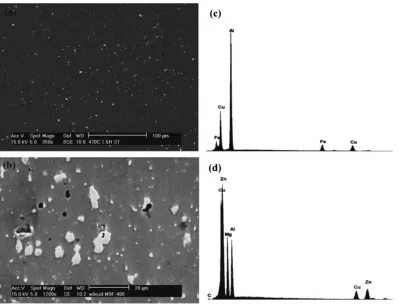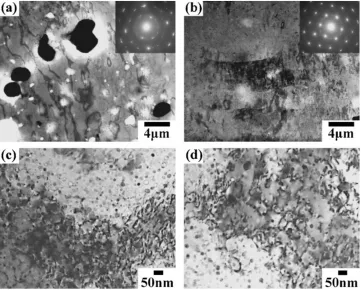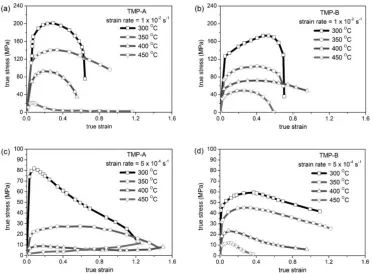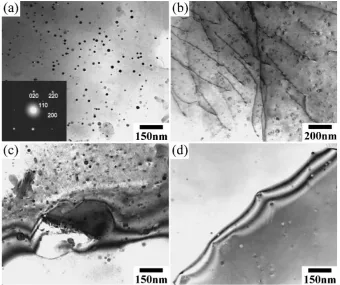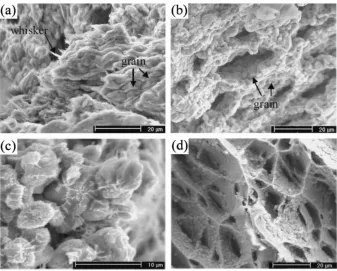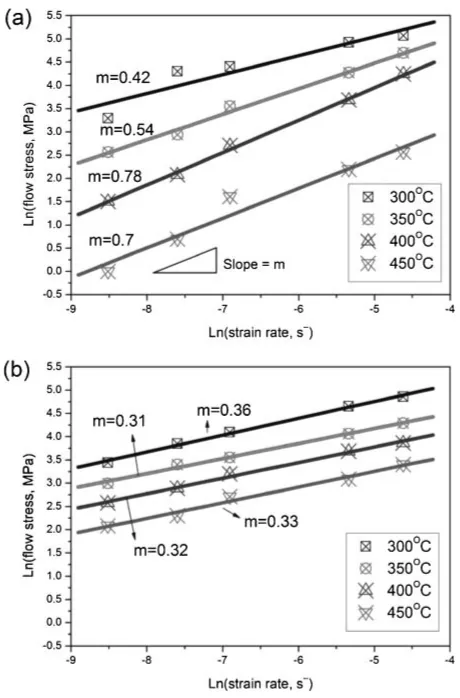Influence of Overaging on the Superplastic Behavior
of an Al-Zn-Mg-Cu-Zr-Sc Alloy
Yi-Yun Li
1, Wen-Hsiung Wang
1;*, Yung-Fu Hsu
2, You-Luen Chang
1and Shan Trong
31
Department of Materials Science and Engineering, National Taiwan University, Taipei, Taiwan 106, R. O. China
2Department of Materials and Mineral Resources Engineering, National Taipei University of Technology,
Taipei, Taiwan 106, R. O. China
3Materials and Electro-Optics Research Division, Chung-Shan Institute of Science and Technology,
Lung-Tan, Taiwan 325, R. O. China
This study examines the influence of overaging on the superplastic behavior of an Al-8.55Zn-2.65Mg-2.48Cu-0.1Zr-0.06Sc alloy (in mass%). Results show that the M-phase particles formed during overaging play the most crucial role during the high-temperature tensile deformation of the Al-Zn-Mg-Cu-Zr-Sc alloy. Even though specimens without overaging maintain their small grain structure due to the existence of fine coherent Al3(ScxZr1x) particles, overaged specimens exhibit better superplasticity. The presence of liquid-like viscous flow
may be the main factor contributing to the superior superplasticity of overaged specimens. [doi:10.2320/matertrans.MRA2008197]
(Received June 23, 2008; Accepted January 6, 2009; Published February 25, 2009)
Keywords: high-strength aluminum alloy, overaging, superplastic, Al3(ScxZr1x)
1. Introduction
Superplastic forming is an attractive manufacturing proc-ess, and is widely used in numerous alloy systems. Super-plastic forming of aluminum alloys allows the fabrication of complex sheet-metal components for automobile and aero-space applications. Superplastic forming requires small and
stable grains which are usually less than 10mmin diameter.1)
In high-strength 7XXX Al alloys, various thermomechanical processes (TMP) have been developed to produce a fine grain
structure. The TMP first proposed by Wertet al.for 7475 and
7075 alloys is the most famous of these processes, and is considered to be an effective grain refinement method for
Al-Zn-Mg(-Cu) alloys.2) A typical TMP involves solution
treatment, overaging at 400C, warm rolling, and annealing.
During the overaging stage, coarse secondary particles, which are a type of Al-Zn-Mg(-Cu) compound known as M-phase, can form in the Al-Zn-Mg(-Cu) alloys. These particles act as nucleation sites for recrystallization, thereby refining the grain structure and enhancing the superplasticity of the Al-Zn-Mg(-Cu) alloys.
In traditional fine-grained Al-Mg alloys, superplasticity is limited due to significant grain growth during superplastic
deformation.3,4)Thus, it is important to find an effective grain
stabilizing agent for superplastic Al-Mg alloys. Adding Sc as an alloying element is considered to be the most effective way to improve the properties of Al-Mg alloys. Further, the effects of Sc can be greatly amplified by Zr. Therefore, the high-temperature tensile behavior of Al-Mg alloys can be
enhanced by adding Sc and Zr.5,6) The extremely fine and
coherent Al3(ScxZr1x) particles are more thermally stable
than Al3Sc or Al3Zr particles at elevated temperatures,5,7)
which provides greater inhibition of grain growth at high
temperatures.8)
Although many studies have examined superplastic
Al-Zn-Mg(-Cu) alloys9–12) and the effects of Sc and Zr on the
high-temperature tensile behavior of Al-Mg alloys,5–8,13)
few studies discuss the superplastic behavior of high-strength Al-Zn-Mg-Cu-Zr-Sc alloys. To address this gap, the current study examines the influences of overaging and
Al3(ScxZr1x) particles on the high-temperature deformation
behavior of Al-Zn-Mg-Cu-Zr-Sc alloys.
2. Experimental Procedures
Chung-Shan Institute of Science and Technology
(Taiwan) supplied the material used in this study. This sample material had a chemical composition of 8.55Zn, 2.65Mg, 2.48Cu, 0.1Zr, 0.06Sc, 0.04Fe, 0.03Mn, 0.02Ti,
0.04Si, <0:01Cr (mass%), with Al filling the balance. The
alloy was received in an extruded form with a thickness of
12 mm. The TMP concept proposed by Wert et al.2) was
applied to this alloy. The alloy was first hot-rolled at 450C
to a thickness of 9 mm. Solution treatment was conducted in
an air furnace at 470C for 4 h followed by water quenching.
Some specimens of the material were then overaged at
400C for 8 h. Both types of specimens, with and without
overaging, were finally warm-rolled at 200C to a final
thickness of 2 mm, representing a reduction of 77%. In this study, specimens with overaging are called TMP-A and specimens without overaging are called TMP-B. To more
clearly and easily investigate the performance of
Al3(ScxZr1x) and coarse secondary particles during the
high-temperature tensile deformation of the Al-Zn-Mg-Cu-Zr-Sc alloy, this study omits the final high-temperature
annealing in Wert et al.’s research.2) This is because final
high-temperature annealing would dissolve most of the coarse secondary particles in TMP-A in matrix.
Tensile specimens with a gauge length of 10 mm and cross
section of 62mm2 were machined from TMP-A and
TMP-B sheets, with the loading axis parallel to the rolling direction. Tensile tests were conducted at temperatures
between 300C and 450C at a strain rate range of1102–
2104s1. The highest working temperature 450C was
selected based on the DSC experiment that eutectic melting
occurred above 485C to avoid liquid formation. All
temperature tensile tests were conducted on a Hung-Ta HT8150 materials test system with a five-zone furnace operating at a constant crosshead displacement rate. The
value of the strain rate sensitivity, m, was determined
according to the following equation:
m¼@log @log _""
This study used optical microscopy (OM), scanning electron microscopy (SEM) and transmission electron mi-croscopy (TEM) to examine the microstructure of the Al-Zn-Mg-Cu-Zr-Sc alloy after high-temperature tensile tests. The samples chosen for TEM observations were prepared by
mechanical grinding to a thickness of about 10mm, and
further thinned to a thickness of electron transparency using double-jet electro-polishing in a 25% nitric acid and 75%
methanol solution operated at around 30C and 30 V.
Samples were examined on a JOEL-100CXII microscope operating at 100 kV.
3. Results
3.1 Microstructure of thermomechanically processed
specimens
Figures 1(a) and (b) show the influence of overaging on the microstructure of the Al-Zn-Mg-Cu-Zr-Sc alloy. Figure 1(a) is the BSE image of the Al-Zn-Mg-Cu-Zr-Sc alloy after solution heat treatment. Some small white
inclu-sions appear in the matrix, and most of them are Al7Cu2Fe
compounds (Fig. 1(c)). These Al7Cu2Fe compounds are
insoluble by solution treatment, and usually appear in
high-strength Al-Zn-Mg-Cu-Zr-Sc alloys.8)Figure 1(b) is the BSE
image of TMP-A after overaging treatment at 400C for 8 h.
Coarse secondary particles formed during overaging are present in the alloy, and can be identified as Al-Zn-Mg-Cu compounds (Fig. 1(d)). These coarse Al-Zn-Mg-Cu com-pounds, also known as M-phase, can introduce higher strain energy during warm-rolling and act as nucleation sites to
refine grain structure during recrystallization.2)
Figures 2(a)–(d) show the TEM images of TMP-A and TMP-B in the as-rolled state. Both Fig. 2(a) and (b) show the typical highly deformed microstructure of Al alloys. Several coarse and small hollows appear in TMP-A (Fig. 2(a)). The interfaces between the M-phase particles and the matrix introduce a chemical potential difference that accelerate the dissolution of the interfaces. Therefore, the coarse hollows in TMP-A can be regarded as the original sites of coarse M-phase particles, and small hollows are the
sites of smaller M-phase particles or Al7Cu2Fe particles.
Figure 2(b) shows that few hollows appear in TMP-B. Figures 2(c) and (d) are the corresponding TEM images of Figs. 2(a) and (b), respectively, at a higher magnification. Both small round M-phase particles and fine spherical
Al3(ScxZr1x) particles appear in TMP-A and TMP-B in the
as-rolled state. These small round M-phase particles mostly
form during warm-rolling at 200C, while the fine spherical
Al3(ScxZr1x) particles mostly form during material making
processes such as casting, homogenization, and extrusion. Both of these particles interact with dislocations during warm-rolling.
Fig. 1 SEM microstructure of the Al-Zn-Mg-Cu-Zr-Sc alloy after: (a) solution treatment and (b) overaging; (c) and (d) shows EDS analysis result of the white particles in (a) and (b), respectively.
[image:2.595.102.501.70.375.2]3.2 High-temperature tensile behavior
Figures 3(a) and (b) show the optimal elongation at various temperatures for TMP-A and TMP-B, respectively. These figures show that TMP-A exhibits better ductility than
TMP-B at temperatures ranging from 350–450C. The
high-temperature tensile behaviors of both TMP-A and TMP-B are not very outstanding. The maximum elongation in TMP-A
was just 421% at 400C and5104s1. However, TMP-A
achieved an acceptable elongation of 402% when deformed
at 450C and 1102s1. The strain rate 1102s1 is
high, and an elongation of 402% is acceptable in common
superplastic applications.14) The barely acceptable ductility
performance of TMP-A may be due to the elimination of
the final recrystallization step used in Wertet al.’s study.2)
The alloy could not achieve the equiaxed grain structure essential to the sliding of the grain boundary. Figures 4(a)–
(d) show the true stress-strain curves of TMP-A and TMP-B
specimens deformed at strain rates of 1102s1 and
5104s1at various temperatures. At a higher strain rate
of1102s1(Fig. 4(a) and (b)), TMP-A has a higher flow
stress than TMP-B a temperatures ranging from 300–400C,
while at 450C, TMP-A had a lower flow stress than TMP-B.
In addition, at a lower strain rate of 5104s1 (Fig. 4(c)
and (d)), the flow stress of TMP-A remained higher than
TMP-B at 300C, while the flow stress of TMP-A was lower
than TMP-B above 350C.
Figures 5(a) and (b) show the TEM images of the grain structures of TMP-A and TMP-B after high-temperature
deformation at 450C and 1102s1, and 400C and
5103s1, respectively. Both specimens experienced
approximately the same testing period, including 15 mins isothermal holding and nearly 7 mins deformation time, and
Fig. 2 TEM micrographs of (a) TMP-A and (b) TMP-B; (c) and (d) are the higher magnification of (a) and (b), respectively.
Fig. 3 Appearances of the optimal elongation at various temperatures of (a) TMP-A and (b) TMP-B.
[image:3.595.118.479.72.362.2] [image:3.595.119.476.401.557.2]showed a very small grain size of 3mm. Many small hollows appear in the grain boundaries in the TMP-A sample, while only few hollows appear in the TMP-B grain boundaries. The incompletely dissolved coarse M-phase particles remaining after high-temperature deformation generated these small hollows.
Fine and coherent spherical Al3(ScxZr1x) particles also
appear in both TMP-A and TMP-B specimens after high-temperature deformation (Fig. 6). These particles are
ex-tremely small: 23 nm in TMP-A after deformation at 450C
and 1102s1; 18 nm in TMP-B after deformation at
400C and5103s1. The TMP-A and TMP-B specimens
exhibit no great differences in the size and the density of
Al3(ScxZr1x) particles. These particles had strong
interac-tion with the dislocainterac-tions (Fig. 6(b)) and the grain boundaries
during deformation.13)In TMP-A (Fig. 6(c)), both the coarse
M-phase particles and the Al3(ScxZr1x) particles strongly
interacted with the grain boundaries. On the other hand, the coarse secondary particles were absent from the
grain boundary interaction in TMP-B (Fig. 6(d)). The
Al3(ScxZr1x) particles effectively maintained the fine grain
structure in TMP-B (Fig. 5(b)).
3.3 Fracture behavior
Figures 7(a) and (b) show the SEM fractographs of TMP-A and TMP-B specimens after high-temperature tensile
deformation at 400C and 5104s1. Both the TMP-A
and TMP-B fracture modes were intergranular that the topography of the grains was clearly seen. Whiskers on the TMP-A fracture surface were also observed (Fig. 7(a)), whereas no whiskers were found in TMP-B (Fig. 7(b)). The
TMP-A whisker formation at a strain rate of 5104s1
occurred in a temperature range of 350–450C, which is
close to the overaging temperature of 400C. Notice that
TMP-A exhibits lower flow stress than TMP-B at a strain
rate of 5104s1 (Figs. 4(a) and (b)) at temperatures
ranging from 350–450C. These whiskers frequently appear
in high-strength 7XXX aluminum alloys after
high-temper-Fig. 4 True stress-strain curves of TMP-A and TMP-B tested at strain rates of1102s1and5104s1at various temperatures.
Fig. 5 TEM microstructure of (a) TMP-A after deformation at 450C and1102s1and (b) TMP-B after deformation at 400C and 5103s1.
[image:4.595.112.485.70.344.2] [image:4.595.113.484.380.516.2]ature tensile deformation, and are thought to be evidence for a liquid-like viscous flow originating at the grain
boundaries.12)In addition, the grain size of TMP-B (6mm)
remained quite small after deformation, which is even
smaller than TMP-A (9mm). Though superplastic is
feasible in small grains, typically less than 10mm, the
high-temperature tensile behavior of TMP-B was quite poor. Figures 7(c) and (d) show the fractographs of TMP-A
and TMP-B after deformation at 450C and 1102s1.
In this case, TMP-A specimens had a flow stress lower than TMP-B. The topography of TMP-A grains was ‘‘wet’’, which is also an evidence of the partial melting of M-phase particles. On the other hand, the topography of TMP-B was ‘‘dry’’, which indicates typical ductile fracture characteristics.
Figures 8(a) and (b) show the OM images of the gauge sections near the fracture tip of TMP-A and TMP-B after
deformation at 400C and5104s1. These figures show
that TMP-A endured more cavitations than TMP-B. Com-paring to Fig. 7(a) and (b), even with the absence of coarse M-phase particles, the grains in TMP-B remain small, and even smaller than grains in TMP-A after deformation.
4. Discussion
4.1 High-temperature tensile behavior of overaged
specimens
Coarse M-phase particles forming during the overaging process can serve as recrystallization nucleation sites,
there-by refining the grain structure of Al-Zn-Mg(-Cu) alloys.6)In
addition, these particles appear to inhibit grain growth and
maintain a fine grain structure during high-temperature tensile deformation (Figs. 5(a) and 6(c)). Moreover, Fig. 7(a) and (c) show that adequate partial melting of the coarse M-phase particles can enhance solvent diffusivity and form a
liquid-like diffusion flow.12)This liquid-like diffusion flow
lubricates the grain boundary during high-temperature deformation, and in turn, relaxes the stress concentration at the junction of the grain boundaries. Therefore, when tested
at a lower strain rate of 5104s1 (Fig. 4(c) and (d)),
partial melting of the M-phases particles at 350–450C had
sufficient time to let the solvent atoms diffuse. This in turn releases the stress concentration at the grain boundaries, and reduces the flow stress in A to be even lower than
TMP-B. At a higher strain rate of 1102s1, the liquid-like
diffusion flow can only effectively offset the stress accumu-lation at grain boundaries when deformed at a high
temper-ature of 450C where diffusion is very fast, as a result, the
flow stress of TMP-A was lower than TMP-B at temperature
of 450C (Figs. 4(a) and (b)). The reduction of flow stress in
Fig. 4 may be evidence for strain energy releasing caused by
the partial melting of coarse M-phase particles. Jianget al.
produced similar results, in that the strain hardening of overaged specimens was lower than that of non-overaged
specimens.15)
Figures 8(a) and (b) show that the liquid-like diffusion flow may help withstand higher void coalescences during
high-temperature tensile deformation.12)
4.2 High-temperature tensile behavior of non-overaged
specimens
The combination of Sc and Zr additives causes the
Fig. 6 TEM micrographs of: (a) the Al3(ScxZr1x) particles and (b) the interaction between the Al3(ScxZr1x) particles and dislocations in
TMP-B after deformation at 400C and5103s1; the grain boundaries of (c) TMP-A after pulling to failure at 450C and 1102s1and (d) TMP-B after deformation at 400C and5103s1.
[image:5.595.128.468.72.357.2]formation of Al3(ScxZr1x) particles with very attractive
properties. These particles nucleate rapidly at high number densities, are homogeneously distributed, and coarsen quite
slowly.16,17)These Al3(ScxZr1x) particles stabilize the grain
structure of the alloy and prevent recrystallization after hot working by pinning grain and subgrain boundaries. In our
previous study,13) we found that Al
3(ScxZr1x) particles
showed significant interaction with the dislocations and grain boundaries in a cold-rolled Al-6Mg-0.4Sc-0.13Zr alloy at
temperatures of 400C and 450C. The
Al-6Mg-0.4Sc-0.13Zr alloy resulted in poor ductility at 400C and 450C;
it was not until the alloy was deformed at temperature above
500C that the alloy exhibited excellent ductility of 1100%.
The Al3(ScxZr1x) particles maintain the grain structure quite
effectively at very high temperatures.13) However, without
enough thermal activation, these particles act as heavily pinning nails, strongly impeding dislocation restoration and degrading grain boundary mobility during high-temperature
deformation.13) The thermal activation energy in this study
was not enough to help the dislocations and grain boundaries
overcome the super-high zener pinning pressure caused by
the extremely fine Al3(ScxZr1x) particles at 400C and
450C. Without the partial melting of the coarse M-phase
particles, the strain energy cannot be released and the diffusion is slow, resulting in poor grain boundary mobility. This may be the reason why TMP-B ductility is less than
TMP-A even though the strong pinning Al3(ScxZr1x)
particles at the grain boundaries effectively maintained the fine grain structure in TMP-B after high-temperature tensile deformation.
4.3 Strain rate sensitivity
Figures 9(a) and (b) plot the flow stress logarithm as a function of the strain rate logarithms of TMP-A and TMP-B, respectively. TMP-A exhibits higher strain rate sensitivities
(m) than TMP-B at temperatures ranging from 350–450C,
e.g., at 350C, mA¼0:54while mB¼0:31; at 400C, mA¼
0:78 while mB¼0:32; at 450C, mA¼0:70 while
mB¼0:33. The high m values of TMP-A at temperatures
from 350–450C were in excess of 0.5, indicating that grain
Fig. 8 Gauge sections of (a) TMP-A and (b) TMP-B after deformation at 400C and5104s1.
Fig. 7 SEM fractographs of (a) TMP-A and (b) TMP-B after deformed at 400C and5103s1; (c) TMP-A and (d) TMP-B after
deformed at 450C and1102s1.
[image:6.595.129.466.70.341.2] [image:6.595.129.471.386.513.2]boundary sliding plays an important role. This implies that the high m value of TMP-A is also the consequence of partial melting of M-phase particles even though the small grains in
TMP-B were maintained solely by Al3(ScxZr1x) particles
during high-temperature tensile deformation.
With respect to superplastic deformation, Al3(ScxZr1x)
particles can not only refine the grain structure of Al alloys8)
but can also prevent excessive grain growth at
high-temper-atures.5,13)Though the small grain structure of TMP-B was
effectively retained solely by extremely fine Al3(ScxZr1x)
particles, and the grain structure of TMP-B could be smaller than TMP-A after high-temperature deformation, the elon-gation of TMP-B was poorer than TMP-A.
Although TMP-A overaging conducted at 400C may be
suitable for the precipitation and growth of Al3(ScxZr1x)
particles,18) the limited amount of Sc and Zr in the alloy
restrict the coarsening kinetics of the Al3(ScxZr1x) particles.
In addition, the insoluble property of these particles does not
grow via Ostwald ripening mechanism.19) Therefore, no
significant coarsening of the Al3(ScxZr1x) particles occurs in
TMP-A. Assuming that the small M-phases formed during warm-rolling rapidly dissolve in the matrix and the influences
of the Al3(ScxZr1x) particles during deformation in both
TMP-A and TMP-B are similar, the main difference in
high-temperature deformation between TMP-A and TMP-B is the existence of the coarse M-phase particles. The M-phase particles formed during overaging still play the most crucial role in enhancing the high-temperature ductility of Al-Zn-Mg-Cu-Zr-Sc alloys.
5. Conclusion
The coarse M-phase particles formed during overaging play the most crucial role in the high-temperature tensile tensile deformation of the Al-Zn-Mg-Cu-Zr-Sc alloy. These particles partially melt during high-temperature deformation, which relaxes the stress concentration, assists grain boundary sliding, and endures more cavity coalescences. Coarse M-phase particles also lead to great flow stress reduction and higher strain rate sensitivities. Since no coarse M-phase particle melt during high-temperature tensile deformation in non-overaged specimens, these specimens exhibited less ductility than overaged specimens. This result occurred despite the fact that non-overaged specimens can also maintain their small grain size at high temperature due to
the existence of Al3(ScxZr1x) particles effectively retarding
the grain growth.
Acknowledgements
The authors would like to thank the Chung-Shan Institute of Science and Technology (Taiwan) for financially support-ing this research under Contract BV95E03P038PE.
REFERENCES
1) O. D. Sherby and J. Wadsworth: Prog. Mater. Sci.33(1989) 166. 2) J. A. Wert, N. E. Paton, C. H. Hamilton and M. W. Mahiney: Metall.
Trans.12A(1982) 1981–1267.
3) A. Friedman and A. K. Ghosh: Metall. Mater. Trans. A 27(1996) 3827–3839.
4) D. H. Bae and A. K. Ghosh: Acta Mater.48(2000) 1207–1224. 5) S. Lee, A. A. Utsunomiya, H. Akamatsu, K. Neishi, M. Furukawa, Z.
Horita and T. G. Langdon: Acta Mater.50(2002) 553–564. 6) H. B. Geng, S. B. Kang and B. K. Min: Mater. Sci. Eng. A373(2004)
229–238.
7) S. Fujikawa: J. Jap. Inst. Light Met.49(1999) 128–144.
8) Z. Yin, Q. Pan, Y. Zhang and F. Jiang: Mater. Sci. Eng. A280(2000) 151–155.
9) R. Kaibyshev, T. Sakai, F. Musin, I. Nikulin and H. Miura: Scr. Mater. 45(2001) 1373–1380.
10) Z. Y. Ma and R. S. Mishra: Acta Mater.51(2003) 3551–3569. 11) D. H. Shin, C. S. Lee and W. J. Kim: Acta Mater.45(1997) 5195–5202. 12) W. D. Cao, X. P. Lu and H. Conard: Acta Mater.44(1996) 697–706. 13) Y. Y. Li, W. H. Wang, Y. F. Hsu and S. Trong: Mater. Sci. Eng. A497
(2008) 10–17.
14) K. T. Park, D. Y. Hwang, Y. K. Lee, Y. K. Kim and D. H. Shin: Mater. Sci. Eng. A341(2003) 273–281.
15) X. G. Jiang, Q. Wu, J. Z. Cui and L. X. Ma: J. Mater. Sci.28(1993) 6035–6039.
16) V. G. Davydov, V. I. Elagin, V. V. Zakharov and D. Rostoval: Met. Sci. Heat Treat.38(1996) 347–352.
17) V. V. Zakharov: Met. Sci. Heat Treat.39(1997) 61–66. 18) J. Røyset and N. Ryum: Inter. Mater. Rev.50(2005) 19–44. 19) F. J. Humphreys and M. Hatherley: Recrystallization and Related
Annealing Phenomena, (Oxford, Pergampn, 1995). Fig. 9 Logarithm of flow stress is plotted as a function of the logarithm of
strain rate: (a) TMP-A; (b) TMP-B.
[image:7.595.54.284.69.418.2]